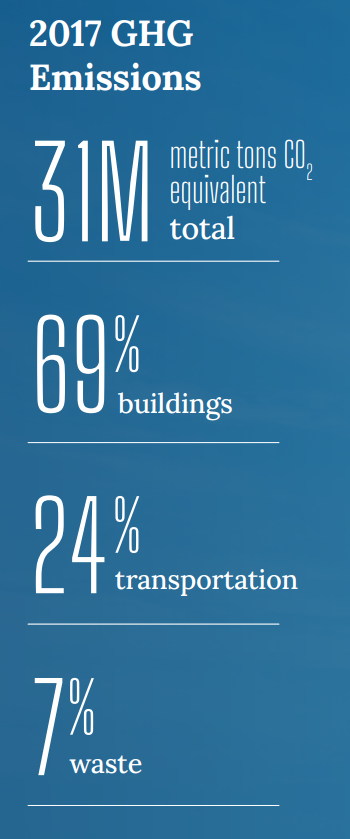Electrify Chicago
An independent tool for viewing City of Chicago building data
According to the
2022 Chicago Climate Action Plan,
69% of Chicago's emissions come from buildings, making
building emissions our biggest challenge and our biggest opportunity as a city
to tackle climate change. At Electrify Chicago, we showcase building performance using
publicly available data supplemented by community-submitted photographs and building
owners.
Start by looking at Chicago's buildings with the highest greenhouse gas intensity i.e. emissions per square foot. Large, efficient, buildings can perform much better than very inefficient small buildings on this metric.
New Article
📰 $30 Million In Missed Fines
The City Of Chicago failed to collect $30 million in potential fines from the building benchmarking ordinance, reducing transparency and accountability.
Legislative update! 🎉
As of late January 2024, legislation is being introduced to require new use more efficient forms of water and space heating, via the Clean And Affordable Buildings Ordinance (CABO), which will reduce the number of highly polluting and inefficient buildings that end up on this site.
If you're in Chicago,
write to your alderman to support the CABO!
Chicago Buildings by Greenhouse Gas Intensity
Note: Data includes large Chicago buildings with data from 2022, unless explicitly stated otherwise.
Note: This data only includes buildings whose emissions are reported
under the
Chicago Energy Benchmarking Ordinance. According to the City “As of 2016,
this list includes all commercial, institutional, and residential buildings larger than
50,000 square feet.” This dataset is also then filtered to only buildings with
reported emissions > 1,000 metric tons CO2 equivalent.
The latest year of data is from 2022, but we update the site regularly when new data is available, and some buildings may have failed to report that year, and only have older data available.
| Property Name / address | Primary Property Type |
Greenhouse Gas Intensity (kg CO2 eq./sqft) |
Total Greenhouse Emissions (metric tons CO2 eq.) |
|---|---|---|---|
|
-
4423 N Sheridan Ave
| Multifamily Housing | 5.6 kg/sqft
Lowest 35%
| 520 tons
Lowest 28%
|
|
The Park Monroe Condominium Homes Association
65 E Monroe St
| Multifamily Housing | 5.6 kg/sqft
Lowest 35%
| 2,709 tons
Highest 16%
|
|
Young Elementary -CPS
🕰️
(CPS)
1434 N Parkside Ave
| K-12 School | 5.6 kg/sqft | 987 tons |
|
StMonica_School
🕰️
5115 N Mont Clare Ave
| K-12 School | 5.6 kg/sqft | 303 tons |
|
Eberhart Elementary -CPS
(CPS)
3400 W 65th Place
| K-12 School | 5.6 kg/sqft
Lowest 35%
| 918 tons
Highest 48%
|
|
Penn Elementary -CPS
🕰️
(CPS)
1616 S Avers Ave
| K-12 School | 5.6 kg/sqft | 892 tons |
|
Grant Campus -CPS
🕰️
(CPS)
145 S Campbell Ave
| K-12 School | 5.6 kg/sqft | 906 tons |
|
Burnside Scholastic Academy -CPS
🕰️
(CPS)
648 E 91st Pl
| K-12 School | 5.6 kg/sqft | 693 tons |
|
Henderson Elementary, CPS
🕰️
(CPS)
5640 S Wolcott
| K-12 School | 5.6 kg/sqft | 452 tons |
|
Air Force Academy (Abbott Elementary ) -CPS
🕰️
(CPS)
3630 S Wells St
| K-12 School | 5.6 kg/sqft | 380 tons |
|
Libby Elementary -CPS
🕰️
(CPS)
5300 S Loomis Blvd
| K-12 School | 5.6 kg/sqft | 650 tons |
|
Ebinger Elementary -CPS
(CPS)
7350 W Pratt Ave
| K-12 School | 5.6 kg/sqft
Lowest 35%
| 524 tons
Lowest 28%
|
|
Mitchell, Ellen -CPS
(CPS)
2233 W Ohio St
| K-12 School | 5.6 kg/sqft
Lowest 35%
| 317 tons
Lowest 10%
|
|
1150 West Fullerton Bldg
(DePaul)
1150 W Fullerton Ave
| College/University | 5.6 kg/sqft
Lowest 35%
| 293 tons
Lowest 8%
|
|
100 E Huron CA
100 E Huron St
| Multifamily Housing | 5.6 kg/sqft
Lowest 35%
| 2,822 tons
Highest 15%
|
Data Source:
Chicago Energy Benchmarking Data
